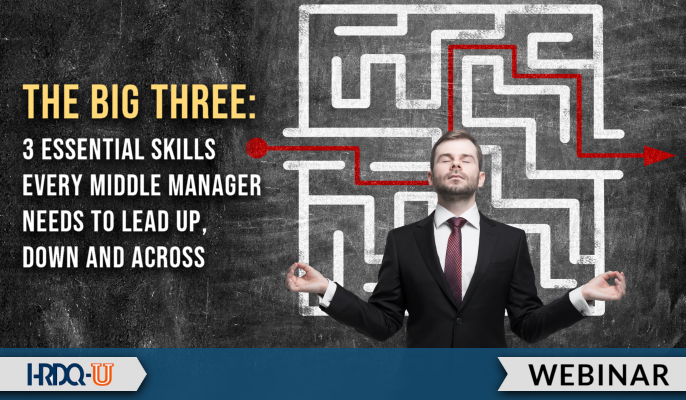- 827 Lincoln Ave. #B-10 West Chester, PA 19380
- support@hrdq.com
- +1-610-279-2002
Quick Links
Menu
Featured Topics
Menu
Total Results
We could not find what you're looking for. Please try again.No Record Found
Don’t miss this upcoming event from HRDQ-U

As a leader in an ever-changing world, your leadership can be tested daily, even hourly! Although you can, and should, celebrate the successes and milestones, you know the frustrations and annoyances can seem, more often than not, impenetrable. When it comes to leading and managing people, there are many big challenges you need to deal with, but there are some middle manager skills that can help.
Do you
To overcome these and other people management challenges to be a confident, skilled, and successful middle manager, you need to master three core skills.
This webinar is designed to re-connect, re-energize, and re-ignite the core skills in you with the three fundamental skills that will improve communication, workflow, employee engagement, and performance, as well as your own career success. When you apply the learning from this webinar, you will gain confidence and clarity in your leadership. It’s not about doing it all; it’s about doing the right things at the right time!
This live event is free. A recording will be available after the event with an HRDQ-U Membership for Learning Professionals.


Leadership 101
This training program gives new and experienced managers the skills they need to develop and refine their leadership skills to retain employees and clients, make better decisions, and improve performance.
Take 15% OFF with code LEADERSKILLS
Sally Foley-Lewis inspires skills managers to be high-performing, purposeful, and productive. Obsessed with leadership and professional development that ensures people reach their potential. Sally’s presentations and programs positively impact your confidence, leadership, and results.
She is a global professional speaker and has authored multiple books. The drive to support and skill managers comes from her own CEO and senior leadership experiences. Sally delivers presentations, keynote speeches, workshops, and coaching – live online and face-to-face – to skill managers and boost productivity and self-leadership.
Blending 20+ years of working with a diverse range of people and industries in Germany, the Middle East, Asia, and across Australia. Sally has extensive qualifications, a wicked sense of humor, and an ability to inspire and make people feel at ease. Sally’s your first choice for mastering skills, facilitating action, and achieving results.
Connect with Sally on Instagram, YouTube, and at sallyfoleylewis.com.
Training Tools for Developing Great People Skills
This event is sponsored by HRDQ. For 45 years HRDQ has provided research-based, off-the-shelf soft-skills training resources for classroom, virtual, and online training. From assessments and workshops to experiential hands-on games, HRDQ helps organizations improve performance, increase job satisfaction, and more.
Learn more at HRDQstore.com

“The information presented in describing coaching, feedback, and delegation is exactly what I need to start my new job as a program manager. Thank you for taking the time to present this today.”
Chris A.
Program Manager
Goodwill of Orange County

“The presenter was very engaging! She made it easy to stay tuned in and the hour flew by before I knew it!”
Elizabeth S.
Senior Employment Specialist
Goodwill of Orange County

“I loved that the training was done within an hour and touched on important topics. I can definitely do more work on my coaching skills and will use some of the techniques the presenter suggested.”
Joann R.
Supervisory US Probation Clerk
United States Probation Office

Sign up to be notified of upcoming live webinars, in-depth workshops, podcasts, blog posts, promotions and much more. Stay ahead of the curve and subscribe for FREE today!